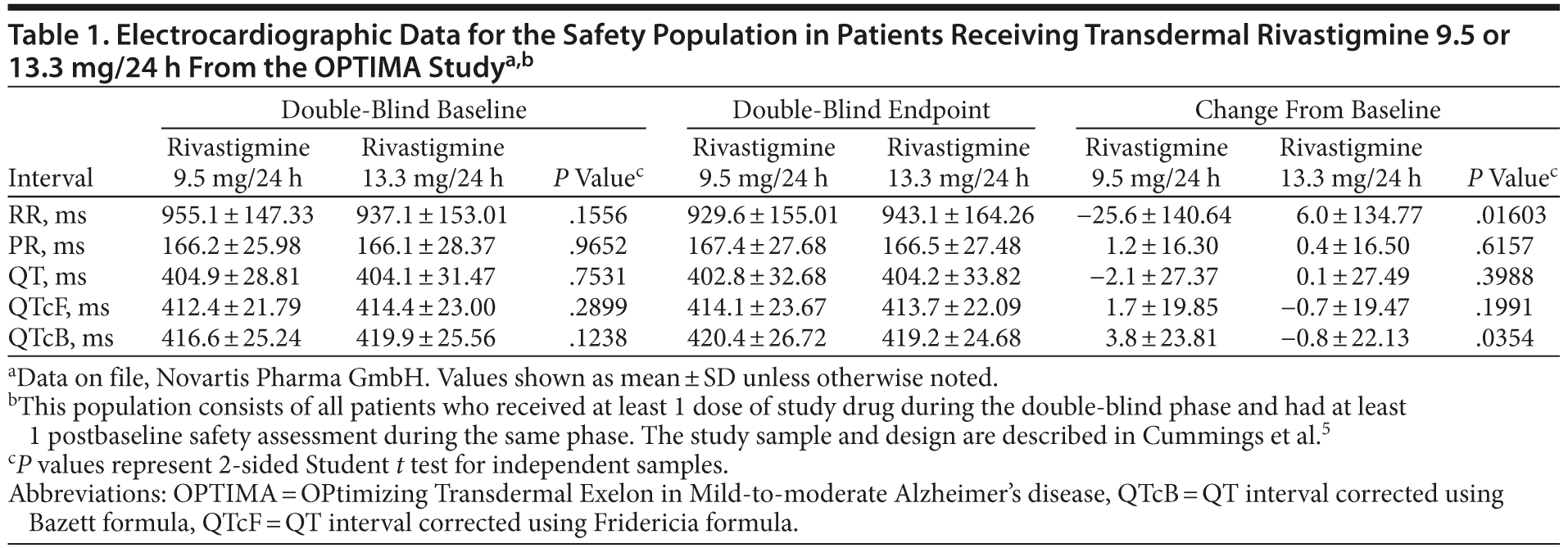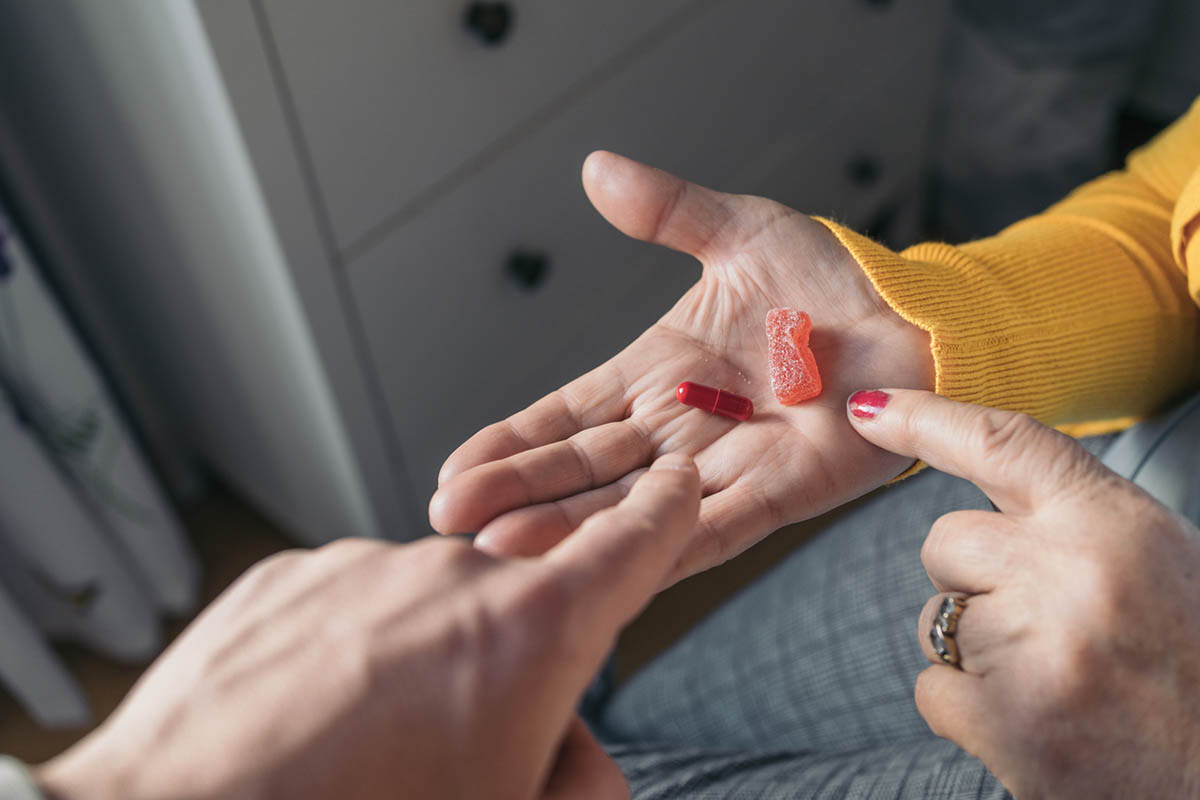High-Dose Cholinergic Therapy With Rivastigmine Patch Does Not Prolong QTc Time in Patients With Alzheimer’s Disease
To the Editor: Cholinesterase inhibitors are widely accepted as established therapeutic intervention across the entire severity spectrum of Alzheimer’s disease. However, fear of increased corrected QT interval (QTc) time is one of the main reasons for nonprescription of cholinergic drugs.1 While it is generally accepted that therapeutic efficacy of cholinergic therapy is dose dependent, a large number of patients are treated with a low dose for fear of dose-dependent increase of QTc time.
Previous studies in small numbers of patients reported that treatment with a low and medium dose of donepezil2 and rivastigmine3 did not prolong QTc time, while treatment with galantamine was shown to be associated with some risk of QTc time prolongation.4 Since these data were obtained, higher doses of donepezil and rivastigmine have been licensed to be used in routine clinical practice. Appraisal of risk of QTc time prolongation with a high dose of any cholinergic drug is thus of great clinical importance to reduce potential undertreatment of patients with Alzheimer’s disease. The objective of the current analysis was to determine whether high-dose rivastigmine patch induces prolongation of QTc time in patients with Alzheimer’s disease.
Method. The study sample and design are described in detail elsewhere5; additional data for this analysis were requested from and provided by Novartis Pharma GmbH. In brief, 1,584 patients were included in an open-label treatment phase with rivastigmine patch 9.5 mg/24 h. A total of 22.1% of these patients were diagnosed with cardiac disease, among whom were 5.4% with coronary artery disease, 5.1% with atrial fibrillation, 3.9% with myocardial infarction, 1.5% with bradycardia, and 1.5% with arrhythmia. The only cardiac exclusion criteria were current diagnosis of severe or unstable cardiovascular disease (eg, unstable coronary artery disease, uncontrolled cardiac arrhythmia) and a current diagnosis of bradycardia (< 50 bpm), sick sinus syndrome, or conduction deficits (sinoatrial block or second- or third-degree atrioventricular block). After 24 weeks of treatment, 567 patients, ie, those who experienced functional or cognitive decline during open-label treatment with rivastigmine patch, entered a double-blind phase in which they either continued treatment with 9.5 mg/24 h (n = 287) or increased the dose to 13.3 mg/24 h rivastigmine patch (n = 280). QTc time was assessed with standard 12-lead electrocardiography; both the Fridericia (QTcF) and the Bazett (QTcB) method were used to calculate frequency-adapted QT time.
Results. At baseline, groups treated with either rivastigmine patch 9.5 mg/24 h or rivastigmine patch 13.3 mg/24 h were comparable regarding heart frequency (RR time), time to travel of the electrical signal from the sinus node to the atrioventricular node (PR time), and time for the electrical depolarization and repolarization of the heart muscle (QT time). Frequency-adapted QT time intervals according to both the Fridericia and the Bazett method were also similar between groups (Table 1). After 48 weeks of treatment in the double-blind phase, the heart frequency was slowed slightly in the group receiving rivastigmine patch 13.3 mg/24 h, while the sinoatrial conduction time was similar in both groups. Likewise, change from baseline for QT time and QTcF time was comparable between groups, and QTcB time even showed a small decrease in the group treated with the higher-dose rivastigmine patch (Table 1).
Fear of cardiac adverse events, namely QTc time prolongation, is a frequent cause of undertreatment with cholinergic drugs in patients with Alzheimer’s disease.1 The present analysis does not provide evidence for QTc prolongation even with high-dose treatment with rivastigmine patch (13.3 mg/24 h). As nearly one-fourth of patients were diagnosed with cardiac disease, these data are also relevant for routine clinical practice and demonstrate that rivastigmine patch is well tolerated and does not increase risk of potentially lethal torsades de pointes.
References
1. Malone DM, Lindesay J. Cholinesterase inhibitors and cardiovascular disease: a survey of old age psychiatrists’ practice. Age Ageing. 2007;36(3):331-333. PubMed doi:10.1093/ageing/afm002
2. Isik AT, Yildiz GB, Bozoglu E, et al. Cardiac safety of donepezil in elderly patients with Alzheimer disease. Intern Med. 2012;51(6):575-578. PubMed doi:10.2169/internalmedicine.51.6671
3. Morganroth J, Graham S, Hartman R, et al. Electrocardiographic effects of rivastigmine. J Clin Pharmacol. 2002;42(5):558-568. PubMed doi:10.1177/00912700222011490
4. Vigneault P, Bourgault S, Kaddar N, et al. Galantamine (Reminyl) delays cardiac ventricular repolarization and prolongs the QT interval by blocking the HERG current. Eur J Pharmacol. 2012;681(1-3):68-74. PubMed doi:10.1016/j.ejphar.2012.02.002
5. Cummings J, Froelich L, Black SE, et al. Randomized, double-blind, parallel-group, 48-week study for efficacy and safety of a higher-dose rivastigmine patch (15 vs 10 cm2) in Alzheimer’s disease. Dement Geriatr Cogn Disord. 2012;33(5):341-353. PubMed doi:10.1159/000340056
Author affiliation: Division of Mental Health & Old Age Psychiatry, Psychiatry II, Ulm University, Günzburg, Germany.
Potential conflicts of interest: Dr Riepe has served on the speakers/advisory board for Novartis.
Funding/support: Data reported were supplied by Novartis Pharma GmbH as requested by the author.
J Clin Psychiatry 2014;75(3):288 (doi:10.4088/JCP.13l08730).
© Copyright 2014 Physicians Postgraduate Press, Inc.






